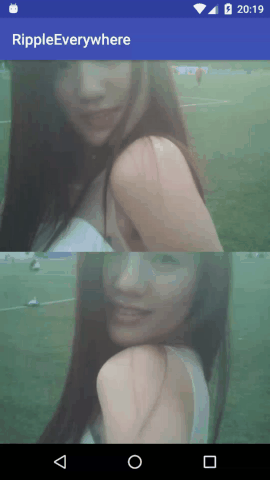本文主要是介绍Android自定义水波纹动画Layout,希望对大家解决编程问题提供一定的参考价值,需要的开发者们随着小编来一起学习吧!
Android自定义水波纹动画Layout
源码是双11的时候就写好了,但是我觉得当天发不太好,所以推迟了几天,没想到过了双11女友就变成了前女友,桑心。唉不说了,来看看代码吧。
展示效果
Hi前辈
话不多说,我们先来看看效果:
这一张是《Hi前辈》的搜索预览图,你可以在这里下载这个APP查看更多效果:http://www.wandoujia.com/apps/com.superlity.hiqianbei
LSearchView
这是一个MD风格的搜索框,集成了ripple动画以及search时的loading,使用很简单,如果你也需要这样的搜索控件不妨来试试:https://github.com/onlynight/LSearchView
RippleEverywhere
女友的照片:
女友的照片:
这是一个水波纹动画支持库,由于使用暂时只支持Android4.0以上版本。https://github.com/onlynight/RippleEverywhere
实现原理
使用属性动画完成该动画的实现,由于android2.3以下已经不是主流机型,故只兼容4.0以上系统。
关于属性动画,如果还有童鞋不了解可以去看看hongyang大神的这篇文章:http://blog.csdn.net/lmj623565791/article/details/38067475。
在我看来属性动画实际上就类似于定时器,所谓定时器就是独立在主线程之外的另外一个用于计时的线程,每当到达你设定时间的时候这个线程就会通知你;属性动画也不光是另外一个线程,他能够操作主线程UI元素属性就说明了它内部已经做了线程同步。
基本原理
我们先来看下关键代码:
@Override
protected void onDraw(Canvas canvas) {if (running) {// get canvas current statefinal int state = canvas.save();// add circle to path to crate ripple animation// attention: you must reset the path first,// otherwise the animation will run wrong way.ripplePath.reset();ripplePath.addCircle(centerX, centerY, radius, Path.Direction.CW);canvas.clipPath(ripplePath);// the {@link View#onDraw} method must be called before// {@link Canvas#restoreToCount}, or the change will not appear.super.onDraw(canvas);canvas.restoreToCount(state);return;}// in a normal condition, you should call the// super.onDraw the draw the normal situation.super.onDraw(canvas);
}Canvas#save()和Canvas#restoreToCount()
这个两个方法用于绘制状态的保存与恢复。绘制之前先保存上一次的状态;绘制完成后恢复前一次的状态;以此类推直到running成为false,中间的这个过程就是动画的过程。Path#addCircle()和Canvas#clipPath()
addCircle用于在path上绘制一个圈;clipPath绘制剪切后的path(只绘制path内的区域,其他区域不绘制)。
radiusAnimator = ObjectAnimator.ofFloat(this, "animValue", 0, 1);/*** This method will be called by {@link this#radiusAnimator}* reflection calls.** @param value animation current value*/
public void setAnimValue(float value) {this.radius = value * maxRadius;System.out.println("radius = " + this.radius);invalidate();
}这一段是动画的动效关键,首先要有一个随着时间推移而变化的值,当每次这个值变化的时候我们需要跟新界面让view重新绘制调用onDraw方法,我们不能手动调用onDraw方法,系统给我们提供的invalidate会强制view重绘进而调用onDraw方法。
以上就是这个动画的全部关键原理了,下面我们来一份完整的源码:
import android.animation.Animator;
import android.animation.ObjectAnimator;
import android.annotation.TargetApi;
import android.content.Context;
import android.graphics.Canvas;
import android.graphics.Path;
import android.util.AttributeSet;
import android.view.View;
import android.view.animation.AccelerateDecelerateInterpolator;
import android.widget.ImageView;/*** Created by lion on 2016/11/11.* <p>* RippleImageView use the {@link Path#addCircle} function* to draw the view when {@link RippleImageView#onDraw} called.* <p>* When you call {@link View#invalidate()} function,then the* {@link View#onDraw(Canvas)} will be called. In that way you* can use {@link Path#addCircle} to draw every frame, you will* see the ripple animation.*/public class RippleImageView extends ImageView {// view center xprivate int centerX = 0;// view center yprivate int centerY = 0;// ripple animation current radiusprivate float radius = 0;// the max radius that ripple animation needprivate float maxRadius = 0;// record the ripple animation is runningprivate boolean running = false;private ObjectAnimator radiusAnimator;private Path ripplePath;public RippleImageView(Context context) {super(context);init();}public RippleImageView(Context context, AttributeSet attrs) {super(context, attrs);init();}public RippleImageView(Context context, AttributeSet attrs, int defStyleAttr) {super(context, attrs, defStyleAttr);init();}@TargetApi(21)public RippleImageView(Context context, AttributeSet attrs, int defStyleAttr, int defStyleRes) {super(context, attrs, defStyleAttr, defStyleRes);init();}private void init() {ripplePath = new Path();// initial the animator, when animValue change,// radiusAnimator will call {@link this#setAnimValue} method.radiusAnimator = ObjectAnimator.ofFloat(this, "animValue", 0, 1);radiusAnimator.setDuration(1000);radiusAnimator.setInterpolator(new AccelerateDecelerateInterpolator());radiusAnimator.addListener(new Animator.AnimatorListener() {@Overridepublic void onAnimationStart(Animator animator) {running = true;}@Overridepublic void onAnimationEnd(Animator animator) {running = false;}@Overridepublic void onAnimationCancel(Animator animator) {}@Overridepublic void onAnimationRepeat(Animator animator) {}});}@Overrideprotected void onLayout(boolean changed, int left, int top, int right, int bottom) {super.onLayout(changed, left, top, right, bottom);centerX = (right - left) / 2;centerY = (bottom - top) / 2;maxRadius = maxRadius(left, top, right, bottom);}/*** Calculate the max ripple animation radius.** @param left view left* @param top view top* @param right view right* @param bottom view bottom* @return*/private float maxRadius(int left, int top, int right, int bottom) {return (float) Math.sqrt(Math.pow(right - left, 2) + Math.pow(bottom - top, 2) / 2);}/*** This method will be called by {@link this#radiusAnimator}* reflection calls.** @param value animation current value*/public void setAnimValue(float value) {this.radius = value * maxRadius;System.out.println("radius = " + this.radius);invalidate();}@Overrideprotected void onDraw(Canvas canvas) {if (running) {// get canvas current statefinal int state = canvas.save();// add circle to path to crate ripple animation// attention: you must reset the path first,// otherwise the animation will run wrong way.ripplePath.reset();ripplePath.addCircle(centerX, centerY, radius, Path.Direction.CW);canvas.clipPath(ripplePath);// the {@link View#onDraw} method must be called before// {@link Canvas#restoreToCount}, or the change will not appear.super.onDraw(canvas);canvas.restoreToCount(state);return;}// in a normal condition, you should call the// super.onDraw the draw the normal situation.super.onDraw(canvas);}/*** call the {@link Animator#start()} function to start the animation.*/public void startAnimation() {if (radiusAnimator.isRunning()) {radiusAnimator.cancel();}radiusAnimator.start();}
}
这篇关于Android自定义水波纹动画Layout的文章就介绍到这儿,希望我们推荐的文章对编程师们有所帮助!








